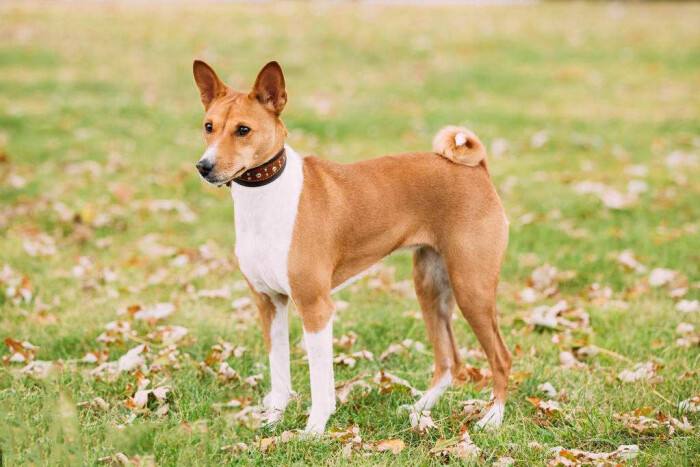Basenji
IUCN
LCBasic Information
Feature
Barks almost nothing, one of the oldest breeds
Distribution and Habitat
Native to Africa
Appearance
The Basenji has a healthy appearance, smooth body parts, beautiful shape, deep wrinkles on the head, tapering from the eyes to the nose, moderate length, black nose, clean cheeks. The ears are erect, short and pointed; the body is medium length, the back is straight, the chest is slightly wide and expanded, and the abdomen is concave upward. The limbs are strong, the muscles are well-proportioned and strong. The tail is set high, close to the back, and curled upward. It has fine short hair, and the hair color is black, white, black and white, brown and white. The body parts are smooth and beautiful. It rarely barks and the call is strange.
Details
Basenji, also known as Congo dog, is also called "barking dog" and is one of the oldest breeds.

This dog has a long history. It originated from the small, short-haired hunting dog in Zaire in the 16th century and has maintained its purebred nature for thousands of years. According to records, this dog was first given as a gift from the source of the Nile to the pharaoh of ancient Egypt. In an ancient Egyptian painting discovered by people, a Basenji dog lies at the feet of the pharaoh. It looks elegant and alert, and has a chivalrous demeanor. After the fall of the ancient Egyptian dynasty, the Basenji dog was lost to the people. Later, the pygmy people in Congo found that the Basenji dog was smart, fast and quiet, so they bred the Basenji dog as a hunting dog, mainly for hunting.
Centuries later, a British explorer discovered the Basenji dog and brought a pair of Basenji dogs to Britain in 1895, but the pair soon died of infectious diseases. Therefore, this dog did not spread in Britain, so that many countries in the world at that time had not heard of the Basenji dog. It was not until 1937 that the Basenji dog was successfully introduced to Britain again, and at the same time, Mrs. Byron Logue of the United States also brought the Basenji dog to the United States. In 1941, Alexander Feminster of Massachusetts got a young Basenji dog brought from Africa. Alexander mated this young Basenji dog with Mrs. Roger's Basenji dog and successfully gave birth to the first litter of purebred Basenji dogs, which grew up healthily in the United States. From then on, American dog lovers began to take an interest in this dog.
In 1942, the American Basenji Club was established and accepted the breed standard drafted by the Basenji Club previously established in the UK. In 1943, the American Kennel Club allowed this dog to be registered in the Good Bottle Registry and recognized this standard.
For thousands of years, Basenji dogs have been bred as hunting dogs. In their place of origin, their intelligence and courage are fully demonstrated. Locals use their sensitive sense of smell to indicate and search for prey, drive prey into nets, hunt injured prey, and use them to hunt mice. It was not until later when Basenji dogs became popular in the world that some people in the United States and the United Kingdom who had the opportunity to learn about Basenji dogs found that they were interesting companions, charming and lovely guys who loved to play, were full of curiosity, and were very lively. They were also very quiet and very suitable for keeping at home. After that, Basenji dogs were not only excellent hunting dogs, but also famous as pet dogs.
Basenji dogs have a competitive and naughty personality, are energetic, kind to people, and like to get close to people. Occasionally show an indifferent expression to strangers. Love cleanliness and wash their faces with their forelimbs like cats. Due to the instinct of living in groups, it also has a tendency to dominate other dogs. If it lives with other dogs, it is inevitable that there will be small competition or fights before the dominance is determined. This dog is prone to obesity and must exercise every day to maintain its figure.
Protect wild animals and eliminate game.
Maintaining ecological balance is everyone's responsibility!








